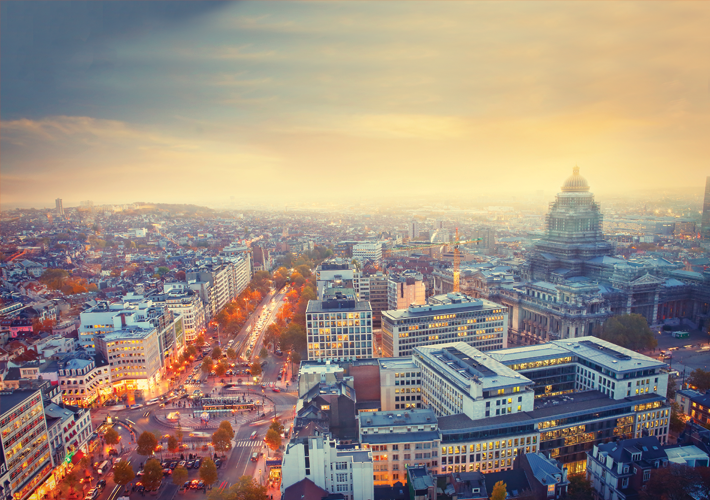
By JP Ervin
Aug 31, 2023
In the September/October issue of Standardization News, ASTM International's director of European affairs, Sara Gobbi, talked about her work with the ASTM's Brussels office. Gobbi leads the office, which focuses on building relationships with European institutions, international bodies, and other stakeholders throughout Europe. She explained the ways ASTM navigates the unique circumstances of European standards and regulations, which have key differences from the US and other parts of the globe. Gobbi also revealed how ASTM is sharing its unique approach, learning from its members and partners in Europe, and otherwise helping our world work better.

As director of European affairs for ASTM International, what do you see as some of the key projects and goals for our Brussels office?
I have proudly led our Brussels Office for the past 10 years, overseeing a diverse range of activities that reflect the broad scope of ASTM International’s work. The Brussels Office operates under the direct guidance of the Global Policy, Cooperation and Communications division, under our vice president, Jeff Grove. Our primary focus is to establish strong connections and relationships with European Institutions, international organizations, and other significant stakeholders in Brussels and throughout Europe.
We maintain close liaisons with European standardization organizations and their national members, UN bodies in Geneva and Vienna, and the Organization for Economic Cooperation and Development (OECD) in Paris. Additionally, we engage with industry representatives from various sectors. One of our essential tasks is to monitor EU policies and legislation that may impact ASTM’s initiatives, providing coordination and feedback when necessary.
Beyond these core responsibilities, our Brussels Office offers support to other departments within ASTM. We actively collaborate with Technical Committee Operations by engaging with our European Union (EU)-based members, developing stakeholder mapping and implementing outreach strategies. By actively engaging with European stakeholders, closely monitoring policy developments, and identifying collaboration opportunities, our Brussels Office plays a crucial role in advancing ASTM’s mission and expanding its relevance in the European and global arenas.
What do you see as some of the key issues, challenges, and opportunities for ASTM as it works with the European standards and regulatory community?
Working with the European standards and regulatory community presents both opportunities and challenges for ASTM. The EU offers a robust commercial market, making it a compelling region for ASTM’s engagement. Additionally, from a technical perspective, ASTM’s growing membership of over 2,000 experts from European member states participating in various technical committees enhances the global reach and relevance of our standards development activities.
One of the significant challenges for ASTM lies in navigating the European regulatory landscape, characterized by a highly centralized and controlled standardization system. The New Legislative Framework (NLF) model underpins several categories of products and services, relying solely on the European standardization organizations (CEN, CENELEC, and ETSI) to develop standards that support regulatory objectives.
READ MORE: Standards for Safer Schools, Safer Children
Furthermore, European laws and recent policies create preferences for standards developed under a “national delegation” approach, as opposed to ASTM’s open model of engagement where individuals participate and vote directly as individuals – regardless of which country or region they are from. I am pleased to note that the OECD published a case study on ASTM and cites our “unique membership structure,” “open participation,” and “inclusive and representative decision-making process” as features that enable ASTM International to quickly develop standards in fast-moving markets “notably around key new production technologies.”
These preferences in EU law and policies make it difficult for non-European standards (ENs), non-ISO standards to be referenced within the body of ENs. Addressing these issues requires institutional-level efforts, and we are fortunate to have the support of our constituency and industry allies who are seeking greater global technical alignment in standards that support regulations and trade.
What do you see as the value that ASTM brings to European standards efforts?
The value that ASTM brings to European standards efforts lies in our commitment to coherence and collaborative work with European stakeholders. We respect the attributes of the European standardization system, which have contributed to building a strong and coherent European single market. With this understanding, we believe in the importance of collaboration and increasing technical compatibility to minimize divergences and misalignment between ENs and ASTM standards. Our efforts focus on promoting technical exchange, avoiding unnecessary duplications, and delivering market-relevant solutions in a timely manner.
The European standardization system could benefit from a more flexible approach to recognizing global technical solutions, especially when anticipating future needs. Sectors that have historically embraced a multiple-path approach to international standards demonstrate the success of this approach. For instance, in areas such as nuclear safety, sustainable and synthetic aviation fuels, and in the design and operation of general aviation aircraft and unmanned aircraft systems (UAS), global consensus standards from ASTM play a crucial role. They are key tools recognized and referenced by European authorities to comply with applicable regulations in these areas.
Conversely, how do you see ASTM benefiting from increased engagement with the European standards community and our members in Europe/EU member states?
That’s vital. Currently, we already have Partner Standards Developing Organization (PSDO) agreements with ISO and IEC, as well as a memorandum of understanding (MoU) to facilitate technical cooperation with CEN. Moreover, we have agreements with EUROCAE and ASD-STAN in the aerospace domain. We are pleased with the cooperation we have established with EU Agencies and bodies, including the Joint Research Center (JRC), the European Aviation Safety Agency (EASA), and the European Organization for Technical Approvals (EOTA). Additionally, we are grateful for the increasing participation of European members who are actively engaged in ASTM for the development of global standards in emerging and digital technologies. These include applications of additive manufacturing, services for UAS traffic management, and many others. As we look to the future, EU members and stakeholders are well-positioned to contribute to the continued development of ASTM’s decarbonization and net-zero standards activities. All these efforts contribute significantly to bolstering ASTM’s reputation and relevance as a well-respected member of the global standards community.
Can you tell us about your background? What led you to become interested in the standards/regulatory world, and eventually to work for ASTM?
I have a legal background and I am bar-admitted in Italy. My first job was with an Italian consultancy firm, where I focused on assisting small Italian businesses in addressing technical barriers to trade within the European Union. These barriers often arose from national requirements and standards that were not compliant with applicable European laws. It was during my twenties that I encountered a standard for the first time, although I didn’t yet know that my career would revolve around standards.
Later, I moved to Brussels and spent some years working for NORMAPME, the European entity representing small and medium-sized companies within the European standardization system (now known as SBS). When the opportunity with ASTM came up, it sparked my intellectual curiosity and felt like a natural progression in my standards-related career journey. I had already experienced the national perspective with the Italian firm, expanded to the European dimension, and now I was ready to embark on a global level with a truly international standards organization.
Sara Gobbi is director of European affairs for ASTM International. Her primary role, at the head of the Brussels office, is to engage in outreach activities and raise greater awareness of ASTM among European institutions, business and trade associations, environmental and consumer groups, and other significant European stakeholders.
September / October 2023
028